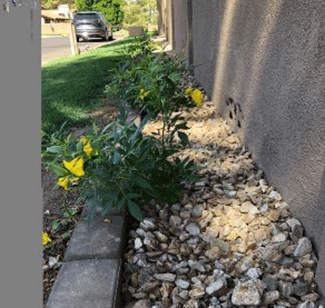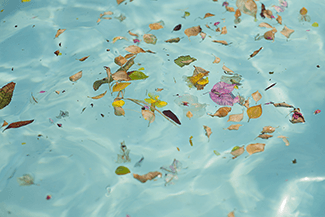“I’ve got plants in bad places, where the swimming pool splashes and the septic tank chases the nutrients away…”
How do you know if the plants or trees in your landscape design are in the ideal place? For example, plants that drop a lot of leaves should not be placed near pools. Never plant root vegetables over septic tanks. Let’s plant the right trees and plants in the right places.
Too Much Plant, Too Little Space

The Arizona Landscape Contractors Association offers a few considerations to discuss with your landscape professional before planting.
Mature size:
Is there enough space for the plant to grow, both in width and height without having to excessively prune to keep it small and compact? The Arizona Municipal Water Users Association (AMWUA) lists mature sizes for many of our low-water-use plants. Rosie suggests thinking ahead and asking yourself what the plant will look like in 10 to 15 years. Will the plant have outgrown its landscaping purpose and function?
Growth habit:
Does it grow tall and upright or have a sprawling growth characteristic? Will you be forced to shear one side of the to get it to ‘fit’ into the space? Just because it appears upright when you buy it doesn’t mean it will continue to grow in this manner.
Environmental factors:
Can influence the ultimate size of a plant. Ample watering of desert plants promotes excess growth of a shrub, causing it to ‘outgrow’ the size it would likely reach if it was watered more conservatively. Exposure may also cause a plant to grow abnormally: a sun-loving plant growing in the shade may reach towards the sun, affecting its size and shape. This often creates a lopsided shrub if planted too close to a structure or wall.
Varieties & cultivars:
There are now several plant varieties (naturally occurring plant variations) and cultivars (nursery-bred or hybridized) with unique characteristics. Make sure when buying plants you know the cultivar’s growth habit and ultimate size. For example, if you buy a Tecoma x ‘Sierra Apricot,’ a shrub that grows three to four feet tall and four to five feet wide, but mistakenly purchase yellow bells (Tecoma stans) the ultimate size of the latter can reach up to twenty feet tall and about fifteen feet wide if it is not cut back annually. That is a significant size difference in two plants with similar names.

Near Foundations
Bob Brown, Owner of Arizona Foundation Solutions, a Rosie on the House Certified Partner, explains there is no set rule on how far away from the house a flower bed or tree should be, but it is important to keep the potential impact in mind when designing landscaping.
Landscaping, irrigation, and drainage play a significant role in the overall performance of your home’s foundation. Trees and other plants pull moisture from the soil under the foundations, which can cause settlement. Irrigated grass is typically overwatered and can potentially induce heaving. You can waterproof a foundation and line flower beds to minimize the potential impact.
Protect your home’s foundation with some landscape changes, including:
- Installing drought-tolerant desert landscaping.
- Making sure existing irrigation lines do not leak.
- Relocating plants and trees that require regular watering away from the home’s foundation.
Around The Swimming Pool
As much as you may desire a tropical paradise in your backyard, be mindful of the plants you place near the pool. Avoid planting these messy plants near the pool unless you want to spend more time skimming out the leaves instead of relaxing in it.
- Acacia
- Azalea
- Bougainvillea
- Crape myrtle
- Dwarf arborvitae
- Honeysuckle
- Ash trees
- Evergreen elm
- Mesquite

Plus, excessive debris can clog up the filtering system and require costly repairs. However, Mark Ragel, board member of the Pool & Hot Tub Alliance Southern Arizona Chapter, encourages his clients to pick the plants they want. “Leaves from four houses away will find their way into the pool,” he says. “Modern skimmers and in-floor cleaning systems with leaf debris removal systems mitigate any leaf issue.”
Make sure the plants you choose match the site’s conditions. Most pools are installed in spaces with direct sun, so the plants you use in the design should be suited for the sunlight. The area around a pool is almost like a microclimate, and the plants you use need to be able to handle it.
Pool water contains chlorine or bromine, both harmful to plants. You’ll see the results — leaves turning yellow or brown (the whole leaf or just around the edges) and extensive leaf drop.
“In a conventional pool, one to four ppm of chlorine will not hurt any plants near a pool,” says Ragel. “Once the pool water hits the soil, the chlorine is rapidly dissipated, and plant damage will not occur.”
Even if your pool uses a salt system instead of a traditional chlorine system, plants can still be at risk for harm. Salt can harm plants in two ways.
Excessive soil salts can be left after water splashes. Leaves, stems, and roots can dehydrate when soil salts become so high that the roots can no longer draw in water. Even if the plants are watered, they can wilt from an inability to absorb the water.
When too many salts are absorbed by the roots they may reach toxic levels and kill the plant. Sonoran native plants are, in general, tolerant of moderate levels of salt in the soil. But most non-native varieties are not. Even small amounts of salt can damage them.
Ragel suggests exercising caution regarding tree roots. He recommends using a root barrier because the roots could invade the pool plaster or plumbing.
Near or on Septic Systems

The drain field also called a leach field of a septic system, is the area on your property where your septic system’s pipes deposit the water from the tank into the ground. The water sinks deep into the soil, where natural bacteria break it down and convert it into nutrients. The remaining liquid evaporates or penetrates far beneath the surface.
Planting perennial flowers grass over and near your septic system is fine. Though plants, shrubs, and trees with deep root systems chase the septic water for nutrition and can grow right into the pipes and through the seams of the tank. Just one measly root can cause never-ending trouble and major repairs.
“If you know where your lines and tank is, avoid planting ANY trees near them,” cautions John Jay Harper, master gardener and regular guest on our Outdoor Living Hour. “The root zone of most trees is at least as wide as they are in spread and in most cases about 50 percent wider. Small shrubs are usually okay, but large bushes like oleander can pose a problem. If in doubt, don’t plant it.”
We would suggest you plant vegetables or edible plants with edible fruit away from septic fields.
ALCA notes that the right plant in the wrong place can become a maintenance nightmare. It requires the landscape maintenance company to prune plants to fit into the allotted space. This becomes problematic for shrubs, reducing bloom and even plant vigor. Plus, the plant will demand more water when in a constant state of stress due to excessive pruning. And that doesn’t help the water conservation efforts in our state. It is best to consult with a knowledgeable landscape professional to determine the best plants for the space, exposure, and microclimate. Reach out to your licensed contractor before planting to make sure you are making the best plant selection for your property.
Always do your research before buying plants and trees.
###
PODCAST
How do you know if the plants or trees in your landscape design are in the ideal place? Leaf litter near pools and root zones that can undermine foundations and sewer lines are just a couple of considerations. We discuss proper spacing and the importance of thinking ahead to what the tree or plant will look like in the future. Plus we discuss listener questions on a remodel involving the sewer line, insulation issues, and a real-time tree placement concern.




















